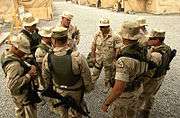Port Security Unit

United States Coast Guard Port Security Units are deployable units organized for sustained force protection operations. They can deploy within 96 hours and establish operations within 24 hours. PSUs conduct OCONUS port security in support of requesting regional Combatant commander. They provide waterside protection to key assets (e.g. pier areas, high-value vessels, harbor entrances) at the termination/origination point of the Sea Lines of Communications (SLOCs). PSUs may operate in U.S. territorial waters under the direction of a Coast Guard or Maritime Defense Zone (MDZ) command or in foreign waters as part of Maritime Expeditionary Security Forces (MESFs) within the Navy Expeditionary Combat Command structure.
PSUs often operate with other MESF elements, such as Maritime Expeditionary Security Squadrons (MSRONs) within a Maritime Expeditionary Security Group, and are part of the Coast Guard's Deployable Operations Group (DOG). However, PSUs are not a regular part of the United States Special Operations Command (USSOCOM).
History
In addition to their most recent support of homeland security operations around the country, PSUs were deployed to the Persian Gulf during Operation Desert Storm in 1990. They also served in Haiti during Operation Uphold Democracy in 1994 and more recently responded to Port-au-Prince, Haiti immediately after the devastating 2010 earthquake. In December 2000, PSU 309 from Port Clinton, Ohio was deployed to the Middle East to provide vital force protection for the Navy assets following the attack on the USS Cole.
The current PSUs evolved out of Coast Guard Ninth District's Reserve PSU program that began in the 1980s, but the port security mission and service goes back even further.
Previously, the Port Security program of the Coast Guard began with the passage of the Espionage Act of 1917 and due to the Black Tom explosion. Coast Guard's Captain of the Port (COTPs) were given responsibility for the security of port areas under this act. During World War I, port security operations were conducted by active duty personnel.
After the war, interest in port security waned until pictures of burning ships visible from US shores as the country entered World War II rekindled media and public attention. The Temporary Reserve was created and made up of armed volunteers under command of the COTP. Over 125,000 citizens would eventually serve as Temporary Reserves.
Capabilities
Each PSU has 6 fast and maneuverable 32' Transportable Port Security Boats (TPSBs). The PSU has a large suite of weapons. Each unit is outfitted with spare material, pick-up trucks, boat trailers, transportable kitchens, tents, and DoD-compatible radios. They maintain an inventory of equipment and spare parts to sustain operations for up to 90 days. Ongoing logistics support provides routine replenishment. All personnel have required individual gear for field operations.
Each PSU is staffed by 140 reservists and 6 active duty personnel (one officer and 5 first-class petty officers). The officer may or may not be a reservist. Personnel prepare for contingency operations during weekend drills and normally participate in either an exercise or specialized training during two weeks of annual Active Duty.
PSUs may operate independently or with other naval coastal warfare units, including:
- United States Coast Guard: High Endurance Cutters (WHEC); Medium Endurance Cutters (WMEC); Patrol Boats
- United States Marine Corps: Fleet Anti-Terrorism Security Teams (FAST)
- United States Army: Military Police (MPs)
- United States Navy: Naval Coastal Warfare Squadron (NCWRONs); Mobile Inshore Undersea Warfare Units (MIUWs); Explosive Ordnance Disposal (EOD) Detachments; Mobile Diving and Salvage Units; Inshore Boat Units (IBUs)
Boat Division

PSUs use six 25' Boston Whalers (four operational, one in maintenance, one pre-staged theater spare), which are the third generation of the Transportable Security Boats (TPSB) used by the Coast Guard for the port security mission. These boats are well-equipped and armed with three mounted machine guns, in addition to the crew's personal weapons.
The mission of the TPSBs is to provide waterside protection to key High Value Assets (HVA) such as U.S. warships and military supply vessels in foreign ports and may include the port, harbor or pier itself. Through the use of vigilant escort and patrol techniques, the HVA is protected from asymmetrical threats such as assaults by small boats or swimmers.
Each TPSB is crewed by 3-4 enlisted personnel, usually Boatswain's Mates, Machinery Technicians, or Port Security Specialists.
Members of PSUs use a variety of light and crew-served weapons. It is the Weapons Division's responsibility to ensure that the Unit is fully armed and trained for any exercise, operation or incident that may arise. The Division consists of a Weapons Officer (WEPO), a Gunner's Mate First Class (GM1), and two or three Gunner's Mates Third Class (GM3s).
The division maintains a variety of weapons, which include the .50 caliber M2 Browning machine gun, M240G machine gun, M4 carbine, M16A2 rifle, 12 gauge Remington 870 shotgun (lethal and non-lethal), and 40 mm M203 grenade launcher. The PSU has recently switched from the 9×19mm Beretta M9 to the .40 S&W SIG Sauer P229R DAK.
Security Division

To most observers the Boat Division remains the most visible element of a PSU. But behind the scenes is the Security Division which is not only tasked to provide protection to vessels in security zones and pier areas but also to provide security for internal unit needs such as the command center, communications center, berthing areas entry control points (ECP), vehicle control points (VCP) and traffic control/vehicle movement.
The Security Division mission is to provide security for the entire PSU as well as assisting the Joint Rear Area Commander's security forces in protecting joint command areas.
The PSU Security Division consists of 40 Maritime Enforcement Specialists (ME's) led by the Unit Security Officer. It is subdivided into squads with 3 four-person fireteams each. Each squad and fireteam has a designated squad or fireteam leader.
Besides general expertise in the missions listed above, security personnel are also trained in defensive position construction, individual movement and patrolling, and assorted weaponry including the M4 carbine, Sig P229, M203 grenade launcher, 12 gauge Remington 870 shotgun (lethal and non), M240G machine gun and .50 caliber M2 Browning machine gun.
Operations
Capable of worldwide deployment, in national defense regional contingency environments, with the exception of polar regions or areas with ice-covered water.
Operating environments are from shore sites or barges. PSUs will normally operate independently, but may operate with a U.S. Navy Mobile Inshore Undersea Warfare Unit, if available.
Capable of conducting continuous boat operations with three or four boats underway simultaneously. An additional boat will be manned and mechanically ready at all times as a ready response boat. The remainder of the boats may be undergoing maintenance or repair or used for spares. Boat hulls can be expected on station (not including transit and maintenance time) 18 hours per day when more than one boat is undergoing maintenance. During high threat conditions, capable of conducting continuous operations with four boats for a maximum period of 24 hours.
Maximum expected boat crew underway period is 8 to 10 hours (with breaks when able) in any 24-hour period. Sufficient personnel have been assigned to provide a three or four section watch rotation for each of the teams (boat crews for three boats, unit security teams, C3 staff) that are required to be manned continuously. This operating tempo can be maintained for 24 hours per day, 7 days per week.
PSUs conduct layered defensive operations to protect high-value assets within the protected waters of a port or harbor. The operation area may extend to the sea buoy if environmental conditions permit. PSU boats are fully mission capable when operating in less than 2-foot (0.61 m) seas and 30-knot (56 km/h) winds. If necessary, PSU boats may operate in up to 4-foot (1.2 m) seas for less than 1 hour with a severely degraded mission capability.
As discussed in section 3.2.2 of reference (e), threats may be posed by aircraft, and surface vessels, including combatants, high speed attack craft, innocuous appearing civilian vessels, swimmer delivery vehicles, divers and mines. PSUs will normally operate in a low threat environment (Level I) as defined in DoD Joint Pub 3-10, Doctrine for Joint Rear Area Operations. They can continue operations if area of responsibility escalates to a medium (Level II) or high threat (Level III) environment if additional security support is provided by the supported commander. If no additional security support is provided, PSU mission capabilities will degrade due to increased requirements for unit self-protection. PSU boat crew fatigue may limit operations in a medium to high threat environment if that operational tempo continues beyond 24 hours.
See also
- Port Security Badge
- United States Coast Guard Reserve
- Maritime Safety and Security Team
- Law Enforcement Detachments
- Joint Maritime Training Center
- Patrol Forces Southwest Asia
External links
- Fact Card
- US Coast Guard
- US Coast Guard Reserve
- Navy Expeditionary Combat Command
- Naval Coastal Warfare Squadron FIVE
- PSU History: USCG Historian's Website
